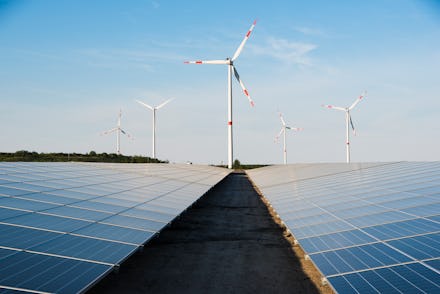The quest for renewable energy could wreak havoc on wildlife, report warns

The future of the planet depends on the widespread adoption of clean, renewable energy sources that don't pour greenhouse gas emissions into the atmosphere. But these safer, smarter, and more efficient forms of energy can have significant negative environmental impacts of their own, depending on how they’ve developed. A new study published Tuesday in the journal Nature Communications highlights the significant amount of mining for metals that must occur to meet the demand of building wind turbines and solar panels, and how simply acquiring those goods could pose a threat to biodiversity.
According to the study, there are 40 essential metals needed to build out the infrastructure required to support renewable energy alternatives. Those materials include bulk metals like iron and aluminum, as well as minerals like cobalt and lithium. It also requires digging up rare earth elements like scandium. Mining for these materials, not specifically for renewable energy projects, accounts for 82 percent of all mining activity at the moment, which occupies more than 20 million square miles of the Earth's land surface. If the mining isn't done mindfully and with respect for the environment, it could do irreparable damage to the planet.
To determine how these mining activities could affect the environment, researchers took a map of all active and planned mines and overlaid it on a map of areas identified as important sites for habitat conservation. What they found is that mining efforts are increasingly making their way onto land that needs to be preserved, with more than three in 10 mines potentially upsetting local ecosystems. Currently, about eight percent of all mines overlap with protected areas. Another seven percent occupy areas that have been identified as key to preserving biodiversity. Another 16 percent of mines have encroached upon wilderness sites.
This problem will likely only be exacerbated as demand for renewable energy increases. Renewable energy sources account for just over 26 percent of all energy generation globally, and that number is continuing to rise. Clean energy overtook coal in the United States for the first time ever this year, and Joe Biden has laid out a plan for a massive expansion to clean energy projects that would get the country to net-zero carbon emissions by 2050. Solar and wind in particular are now cheaper and more efficient than coal, which means that many countries are likely to continue to adopt the technology.
That shift will be great for eliminating new greenhouse gasses that would otherwise be pumped into the atmosphere by burning coal, natural gas, and other fossil fuels. This is an essential part of any plan to combat climate change and one that must be accomplished if there is any hope of staving off the worst outcomes for our planet. But it will still do harm of its own if mining for necessary resources to create renewable infrastructure isn't done responsibly, and early indicators are not promising. According to researchers, mines planned specifically for materials needed for renewable energy projects tend to be densely packed together, which they warn may have a cumulative negative impact on biodiversity, multiplying the effects that might be felt by a single mine.
Some of these harmful effects can already be seen in regions that have become hotbeds for mining activity. In the Republic of Guinea, mining operations have put the country's chimpanzee population at risk by destroying its natural habitat. A similar, unfortunate fate has been thrust upon the already-endangered crested black macaque monkey in Indonesia, where nickel mines have degraded and shrunk their habitat.
The tools and resources for protecting these important lands are already in place, according to researchers. Many materials used in renewable energy projects can be recycled, and policymakers can make protected lands off limits rather than opening them up to potentially harmful mining practices. Recent research has established standards for responsible sourcing methods, which acknowledges the need for these materials while taking extra steps to ensure the process is ethical, doing right by the workers and the environment. Compliance with these standards is key to protecting the planet while also getting the goods we need to shift to clean energy.
Protecting biodiversity while building out renewable energy projects is possible, we just have to actually do it.